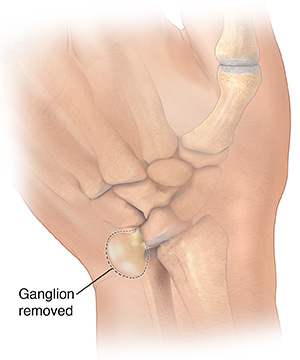Treating Ganglia
Treating Ganglia
A ganglion is a swelling (cyst) that forms on joint and tendon sheaths. They are most often found in the wrist. But they can also show up on the foot, fingers, or toes. Ganglia are believed to be caused by a rupture of the tissue that lines the joints and tendon sheaths (synovial tissue).
Ganglia are sometimes hard to treat without surgery. But nonsurgical methods may help ease some of your symptoms.
Nonsurgical care
Nonsurgical methods are:
Pads placed around the ganglion can ease pressure and friction.
Removing the fluid may also ease symptoms. But ganglia may come back. The gelatinous gel is removed through a large-bore needle. You may get a steroid injection after the cyst fluid is removed.
Limiting movements or activities that increase pain may bring relief.
Icing the ganglion for 15 to 20 minutes may temporarily help with inflammation and pain.
If your inflammation is severe, your healthcare provider may treat your symptoms with medicine.
Surgery
If a ganglion is causing ongoing or severe pain, you may need surgery. Your surgeon removes the whole ganglion wall during the procedure. He or she may also remove some nearby tissue. If the ganglion has come through a tear in the capsule of the joint, the tear may have to be repaired. The joint will likely be protected while the tear heals.
After surgery
You may feel pain, swelling, numbness, or tingling for some weeks after surgery. Be sure to see your healthcare provider if you notice any problems in the future. Although surgery is often successful, there is a chance that the ganglion will come back.
Updated:
January 27, 2018
Sources:
Ganglian cysts of the wrist and hand, UpToDate
Reviewed By:
Joseph, Thomas N., MD,Sather, Rita, RN
